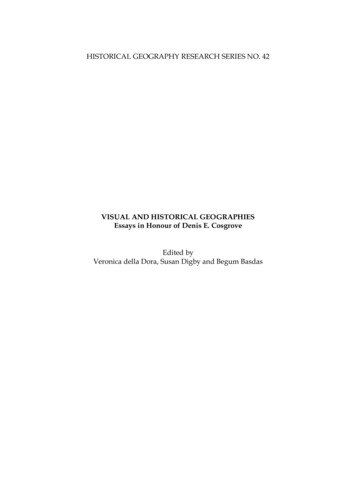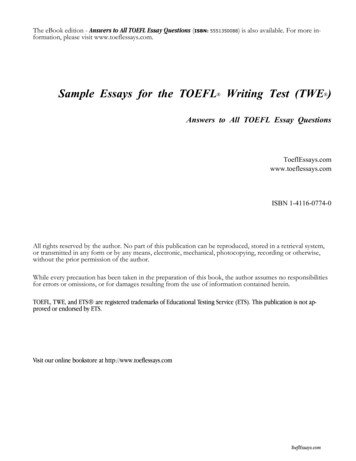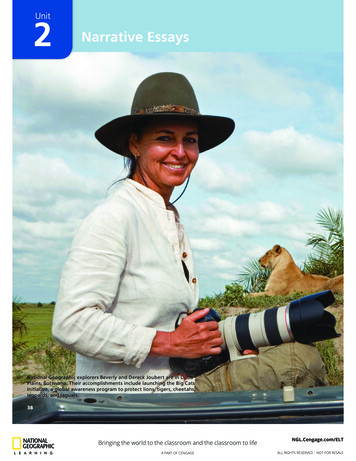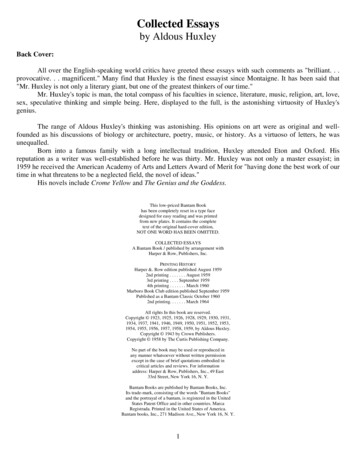
Transcription
HISTORICAL GEOGRAPHY RESEARCH SERIES NO. 42VISUAL AND HISTORICAL GEOGRAPHIESEssays in Honour of Denis E. CosgroveEdited byVeronica della Dora, Susan Digby and Begum Basdasi
Published by:Historical Geography Research group, Royal Geographical Society — Institute ofBritish Geographers, 1 Kensington Gore, London SW7 2ARISBN 1 870074 24 6 The authors 2010The Historical Geography Research Series is produced by the Historical Geography Research Group. The Research Series is designed to provide scholars with an outlet for extended essays of an interpretative or conceptual nature that make a substantive contributionto some aspect of the subject; critical reviews of the literature on a major problem; and commentaries on relevant sources. Contributions to the series are welcome. Manuscripts shouldnot normally exceed 30,000 words in length, inclusive of notes, tables and diagrams, andshould be in English. In addition to single or jointly authored monographs, the Series welcomes edited collections of papers grouped around a topic of research relevant to the broadinterests of the group. Intending contributors should, in the first instance, send an outline oftheir proposed paper to the Editor:Dr. David NallyHonorary Editor of the Research SeriesDepartment of GeographyUniversity of CambridgeCambridge, CB2 3ENUnited Kingdomiiii
Table of ContentsList of Figures . viiAcknowledgements . viiiAbout the Contributors. ixIntroduction: Visual and Historical Geographies. 1Veronica della DoraPART I: VISIONS OF ARCADIA AND WILDERNESS1. Classical Traditions and Cultural Geographies . 9David Atkinson2. The Post-Palladian Landscape: Iconographies of a New Rurality in theVenetian Mainland. 21Francesco Vallerani3. Putting the History in Natural History: Buster Simpson’s Host Analog and Alan Sonfist’s TimeLandscape . 28Paul Kelsch4. Armaments and Art: Holographic Histories at Fort Worden . 38Susan Digby5. Re-Presenting Native Identities: Images as Rhetoric in Struggles over the Arctic NationalWildlife Refuge . 50Joel GeffenPART II: VISIONS OF COSMOPOLIS AND MODERNITY6. Alexandrea ad Aegyptum: Cosmopolitanism and Renaissance Cartographic Visions . 63Veronica della Dora7. Memories, Images, Cosmopolitan Pasts: Galata and Pera in Nineteenth-Century Istanbul. 75Begum Basdas8. Urban Landscape and Amenity in the Modernising City: Nineteenth-Century Yokohama ForeignSettlement. 87Aya Sakai9. ‘Majesty and Multitudinous Resource’: the British Empire Panels in Swansea, 1934 . 95Pyrs Gruffudd10. In the Light of History: Modernism and Landscape Vision in Early Twentieth-Century SouthAfrica. 105Jeremy Foster11. Iconographies Elsewhere: Reading Sri Lankan Landscape in Translation . 119Tariq Jazeelvv
12. Art, Architecture, Artifice and the Imagined Landscape: Reflections on Los Angeles and DenisCosgrove . 130Glen MacDonaldCoda: Geography’s Compass. 139Stephen DanielsThe Role of Geography in the Twenty-First Century: Interview with Denis Cosgrove . 147Helen Sooväli-Seppingvivi
List of Figures1.1.Edward Poynter, Faithful unto Death, 1865 (courtesy of National Museums Liverpool).2.1.Andrea Palladio‘s Villa Saraceno, 1545 (photograph by the author).2.2.Post-modern copy of Villa Saraceno, 1998 (photograph by the author).3.1.John Glashan, ‗History and Natural History‘ (source: Spectator, 29 January 1994,p. 17).4.1.Military battery in the Fort Worden State Park (photograph by the author).4.2.Richard Turner‘s meditative sculptures in Fort Worden State Park (photographby the author).4.3.Unsanctioned art: graffiti at Fort Worden (photograph by the author).5.1.‗Will the caribou go the way of the buffalo?‘ Gwich‘in poster .2.Image of Inupiat ‗whale harvesting‘ (source: http://www.kaktovik.com/).6.1.Georg Braun and Franz Hogenberg, Bird’s-eye view of Alexandria, 1572 (The National Library of Israel, Shapell family Digitalization Project, and The HebrewUniversity of Jerusalem, Dept. of Geography, Historic City Project).7.1.Yüksek Kaldırım Street, Galata, Istanbul, c. 1900 (courtesy of Keystone-Mast Collections, California Museum of Photography).7.2.Karaköy Square, Galata, Istanbul, c. 1900 (courtesy of Keystone-Mast Collections,California Museum of Photography).8.1.Drawing of Yokohama Honmachi Miosaki (courtesy of Yokohama HistoricalArchives).9.1.British Empire Panel No.5 by Frank Brangwyn (City and County of Swansea:Glynn Vivian Art Gallery Collection; reproduced by courtesy of copyright holderDavid Brangwyn).9.2.British Empire Panel No.3 by Frank Brangwyn (City and County of Swansea:Glynn Vivian Art Gallery Collection; reproduced by courtesy of the copyrightholder David Brangwyn).10.1. Spier Outbuildings, nr. Stellenbosch, early 1900s (Arthur Elliot, Cape Archives#E491).10.2. House Stern, Houghton, 1935 (Rex Distin Martienssen Archives, University ofWitwatersrand).11.1. View over Cinnamon Hill at Lunuganga, taken from the main house (photograph by the author).11.2. View over Cinnamon Hill at Lunuganga, taken from the middle ground (photograph by the author).11.3. Paradise, a temporary installation by Thamotharampillai Shanaathanan at Lunuganga, 2003 (photography reproduced with permission from Anoli Perera andthe Theertha Artist‘s Collective, Colombo).12.1. Medical Offices, 696 Hampshire Road, Thousand Oaks, California (photographby the author).12.2. Storer House, 8161 Hollywood Boulevard, Hollywood, California (photographby the author).13.1. David Allan, The Geography Lesson, 1785 (anonymous private collection, reproduced by Sotheby‘s permission).viivii
2The Post-Palladian LandscapeIconographies of New Rurality in the Venetian MainlandFrancesco ValleraniFigs. 2.1 and 2.2. Andrea Palladio’s Villa Saraceno, 1545 and post-modern copy of VillaSaraceno, 1998 (photographs by the author).Villa Saraceno (fig. 2.1) is located in the province of Vicenza, in the Veneto region(north-east Italy). Named after the aristocratic family who commissioned its construction on a pre-existing agricultural annex, the villa is among the earliest andprobably most iconic works by Andrea Palladio (1508-1580). A wide pathway leadsto the entrance of its main building, whose sober symmetrical façade epitomises theideal of harmony and equilibrium sought by one of greatest masters of Italian Renaissance architecture. A few kilometres away from Villa Saraceno is a faithful replicaof the villa‘s main building constructed in 1998 and currently privately owned (fig.2.2). It is a bizarre landmark within the increasingly commodified landscape of Veneto. Two villas, two visions of arcadia: Villa Saraceno serves as the vanishing pointof a wide prospect; as a theatrical stage looking over a carefully engineered harmonious landscape. Its twentieth-century copy, by contrast, exists in a fenced selfenclosed microcosm. A high gate and hedge separate this privatised Arcadian retreatfrom the surrounding world.The images of the two villas speak respectively of a famed historical iconiclandscape and of its contemporary fetishised re-appropriation. Their juxtaposition isjust one of many examples that increasingly characterise the landscape of the Venetoregion. This essay explores emerging tensions within this landscape. In particular, itconsiders how the economic boom of the past two decades has been redefining thehistorical dichotomy between city and country, producing new iconographies thatare aimed more at ‗selling places‘ than at creating the social awareness of ‗a commongood‘ as envisaged by Renaissance makers.121
Veneto and the Palladian landscapeVeneto is the eighth largest region in Italy, with a total area of almost 18,400 squarekilometres. Historically, the region included a significant part of Venice‘s territorialpossessions. However, it was only in the fifteenth century, after establishing an extensive maritime domain along the coasts of the Adriatic and of the eastern Mediterranean (extending as far as Crete and Cyprus), that the imperial city-state turned itseconomic and military interests to the vast plain in the hinterland. This change ofexpansionistic orientation from the sea to the mainland was well justified: a complexgeopolitical configuration of city-states including Verona, Padua, and Treviso startedto be perceived as a possible threat to Venice‘s hegemony.2 But there were also other(and intrinsically geographical) reasons. The Veneto plain is bounded by a preAlpine limestone range which rapidly rises before the massive Alpine barrier of theDolomites. These features result in a thick network of rivers characterised by relatively short courses and irregular flows. The rivers flow into the characteristic amphibious morphology of the Venetian lagoon, producing significant sedimentation.3By the fifteenth century, such morphological dynamics had started to constitute aserious danger to the integrity of the lagoon, which risked being completely filled,thus reducing the military safety of the city.Furthermore, the conquest of the plain and of the pre-Alpine range would havegranted the increasingly populated city a secure supply of cereals. At the same time,pre-Alpine forests would have also provided Venetians with wood for ship construction—the key to Venice‘s success as a maritime superpower. Finally, the Venetiancountryside represented an excellent opportunity to fruitfully invest the revenuesobtained from trade with the Orient. From the beginning of the sixteenth century, anew class of Venetian landowners started to purchase land in the plain and on thegentle hills of Veneto and to commission delightful residences equipped with stables, barns and granaries. Their goal was agrarian profit as much as the fulfilment ofthe exclusive aspirations of a new ‗erudite otium‘.4 It is in this context that we cansituate Palladio‘s role as one of the great craftsmen of a vast territorial project; a project that sought to redefine the economic and cultural rural landscape not only ofVenice, but more generally of Europe itself.Palladio‘s work clearly defines the particular landscape unit of the ‗villa di campagna‘ (countryside villa) as a constitutive element of an aesthetically pleasing and atthe same time economically highly productive environment. 5 As shown by DenisCosgrove, Palladio‘s design work was connected to a rich array of local meaningsthat were in perfect harmony with the socio-economic and cultural aims of a European power in decline in terms of overseas relations, but in powerful expansion inthe functional and aesthetic construction of a hinterland providing some of the highest rural incomes in Europe.6 The iconographic method employed by Cosgrove inthe Veneto area took his studies into philosophy, literature and art, as well as intothe agronomy, hydraulic engineering and trade of the mainland, thereby making acomplete analysis of the semantic sedimentation in which the Palladian ‗signature‘ isset.7 The recent fate of this ‗signature‘ represents a good starting point to reflect onchanging economic and rural aspects of the Veneto region, a region in which thechaotic expansion of private planning and pliant production anarchy paid little heedeither to the symbolic capital of the inherited landscapes or to the ecological and2222
geophysical vulnerability of the local environment.From eulogy to outrageThe muddled, largely unplanned, economic expansion of the 1960-1990 in the Veneto region had the merit of bringing economic well-being and a higher standard ofliving in general, lifting most of the rural population out of the depressed conditionsin which they had found themselves since about the mid 1950s. As recent researchsuggests, the dramatic increase in living standards is in many respects comparable tothe radical transformation of the region that took place at the time of Palladio.8 During and after the post-war boom, however, the land has been envisaged and used asa simple support, as a source of resources, without any consideration for environmental impacts with often dramatic consequences.After decades of reckless development, Veneto is now witnessing the emergence of a new movement to rediscover the traditional countryside. This is essentially a photographic promotion of stereotypical Veneto landscape beauty. Imagesprovide a reactionary propaganda that uses the apparent objectivity of the camera toconceal from the reader, or rather the picture ‗consumer‘, the real and irresponsibledynamics of environmental waste, building speculation and misuse, and social collapse that were beginning to alter the region‘s rural order.The end of the millennium saw the emergence of a new multi-centred mosaic ofactivities and functions which various scholars compared to similar earlier developments in different parts of the world, including Randstaadt (Holland), the Ruhr,and the Los Angeles area.9 Today, Veneto is characterised by a complex heritage ofhistorical landscapes, which recent urban developments are turning into an eclecticmixture of old and new. Although the spreading urbanisation and the fracture oftraditional town-country relationships is undeniable, it is also true that a differentsense of the land has taken shape, one that is less related to local ties but is moreglobal and sustained by a new geography of flows. 10Recent years have also been marked by the expansion of a new ‗green‘ consciousness, with the growth of committees for the protection of the environment andcareful restorations, not only of patrician villas, but also of more modest farmhouses.This, however, has primarily been a time of attentive, prolific promotion of the recreational opportunities provided by a widespread network of river routes, cycletracks, riding trails and walking paths; in other words, with infrastructures associated with the new, self-gratifying ideology of sustainable recreation and with thedemand for more authentic tourist experiences.The consolidation of these shared social attitudes coexists with the recentspread of new chaotic rural dynamics. These are based on the usual processes ofland revenues that continue to eat away at the efficiency of the regional system. Thisconcerns not only the region‘s environmental aspect, but also (and especially) theroad network and residential satisfaction. A journey along a good many of the roadsin Veneto takes you through an uninterrupted urban strip, distinguished by a relentless formal and functional confusion that makes the usual place names accidentaland insignificant. The collective perception of places is increasingly obscured by theplethora of flashy signs advertising manufacturers, shops, restaurants and recreational diversions.112323
Post-Palladian landscape and post-productive countryThe gradual weakening of traditional farming vocations and the subsequent, overwhelming migration of urban population to the country can also be observed in theVeneto. But it occurs with a kind of low-cost suburbanisation, with house sizes similar to those of dormitory suburbs, quite different from the much more prevalentEuropean trend of idealised rural areas. These are seen not only as providing attractive recreational and tourist opportunities, but also as evocative backgrounds againstwhich new existential strategies may be planned and effected. The superiority ofcountry life is another aspect of the Palladian legacy that has influenced the development of European taste for the landscape and holidays. Palladio helped create themoral superiority of the countryside with his villa designs, setting the basis for anattitude to the country that was to take root throughout the Western world.12Beyond this aspect, Cosgrove does not hesitate to relate the Palladian heritageto the current dynamics responsible for the rapidly developing urban sprawl. Therural organisation begun in Palladio‘s time effectively provided the framework forthe current propagation of manufacturing activities, enabled by a well-populatedand easily inhabitable area.13 The villa, like a business structure of today, was a dynamic hub and a driving force for a more efficient use of nature, which was the outcome of rational alterations to the morphology of terrain. This can be read especiallyin the careful choice of sites and the effective management of water, meaning thatnot only the noble building, but also the out-buildings, the water works and the irrigated and reclaimed fields are all prestigious forebears of the current agropolitanmodel of the Veneto.The prototype of the scattered city launched in the Palladian era was, however,governed by strict public control of the business activities centred on the villas,whether involving farming or pre-industrial concerns. It was necessary to keep to astrict body of law, which ensured the correct use of the resources on which the delicate operation of the mainland system rested. These ranged from the felling of treesto the hydro-geological balance of the slopes, from the quality of the water to protection of the shores, and were intended to ensure that the advantages of the individualwould not be to the detriment of the public good. In short, this way of planning thelandscape was very different from what is commonly seen today.The problem with today‘s landscape of the Veneto region (and consequentlywith the economic model by which it has been shaped) is primarily one of environmental degradation. The rural advantages inherited from the centuries-old Palladiantradition, which is still present and can still be defended and repaired for use as aprestigious and environmentally sound tool of urban innovation, are therefore beingpenalised. The precious potential of the landscape as a cultural good is being wasted,the rural marketing potential abandoned, and the growing post-modern demand forpleasantness, or an enjoyable background against which to work and live, ignored.14Most of the locals on the Venetian mainland perceive the Palladian legacy as a completely foreign, if not actually hostile, symbolic surplus.Indeed, the post-Palladian landscape is an intrinsic part of the formal and functional explosion of the post-modern. We are now seeing widespread ‗privatopias‘,cellular territoriality, monumental microcosms and fragments of beauty detached2424
from their context, whose preservation and conscious defence is removed from thecollective imagination, unless it is a question of the places of mass liturgies held inthe name of tourism. Palladio is only a hindrance, a reference to the rural order thatdisturbs the insuperable, incremental choices transforming the quality of the places.It is possible to analyse central Veneto with the cultural idea of an epochal landscape, from the widespread Arcadian landscape of Palladian stamp to the ‗urbanisedArcadia‘ of the more than 300 environmental grassroots committees, a disturbingsumma of damaged landscapes, from which voices that demand to be heard call for ashared rural policy.15Towards an ethics of common goodsPalladian classicism contains another message: the cohesion between ethics and aesthetics—the beauty that improves the world. Further studies derive from the consideration of the Renaissance treatise entitled Le dieci giornate della vera agricoltura (Tendays of real agriculture) by Agostino Gallo, first published in Venice in 1565 and certainly well-known to those commissioning villas from Palladio.16 The current sociocultural reconstruction of the idea of the Veneto landscape, nourished by increasingly elaborate escapist notions aimed at the creation of domestic Arcadias, shows anumber of not negligible points of contact with the sixteenth-century celebration of‗villa pleasures‘. The number of those now living in a countryside detached fromfarm production life has enormously increased.17 In the sixteenth century it wasrather a very small minority, which was also true of most rural areas in the Westernworld. Additionally rural tourism results in large seasonal increases in rural population.Although Renaissance handbooks and the actual reality of villa life reveal a direct and careful control over the quality of the landscape, the post-modern democratisation of ‗holiday house‘ ownership in the former countryside seems to have sanctioned a disturbing disengagement with the environmental impacts of rural urbanisation. This move is undoubtedly detached from the utilitarianism of primary obligations. It rather occurs on the basis of individualistic hedonism. And perhaps this isappropriate, as it confirms the dictates and international canons of ‗country style‘promoted by the glossy magazines, which have the same prestige as the ancient treatises on villa life.Today, the most integral elements of the Palladian landscape are at risk; theyare the object of requests for new developments, which are progressively eroding thePalladian quality, with new roads being opened in the hills and existing ones beingwidened (such as in Arquà Petrarca, Valpolicella, the Prosecco hills, quarries in theBerici hills etc.). Once the personal, private landscape has been obtained, far from thedamage of the urbanised countryside and well protected by a vast array of fences, adangerous social fracture takes place. This leads firstly to a withdrawal into the domestic microcosm, an impeccable Arcadian setting for family use, and then to a disengagement from, and fall-off in, interest for the social control of the land which isleft to the mercy of speculators and the erosion of its environmental quality. This lastaspect is much more evident in highly industrialised areas like the Palladian Venetothan in others, like Provence, Tuscany and Umbria, which still have large areas ofpredominantly traditional landscapes. These are effectively protected, thus restrict2525
ing the contrast with the increasingly widespread scattering of pleasant middle-classretreats, which, like the ancient poderi di spasso da gentiluomo, allow escape from reality; they are gilt cages where it is nice to hide away and play at being ‗farmers‘.18This new perception of the rural reality, no longer dominated by the ties ofproduction, may be assessed by referring to the Renaissance paradigm of renovatio,or the almost utopian need for cyclical renewal, a growing desire for morality andjustice, and the search for a new personal and social equilibrium by changing lifestyles, all within a new idea of nature, a new environmental culture.The recent and recurring threats of global food contamination show the topicalnature of the thoughts on health expressed in the Discorsi intorno alla vita sobria byAlvise Cornaro, once again within the humanist principle of renovatio. The sober lifeis another expression that is widespread in the West, or better, the noun ‗sobriety‘,which along with the other key word, ‗decrease‘, are the conceptual pillars of whatwill be the next ethical approach to more respectful and ecologically viable living.The ideal of an existence in harmony with nature has many more admirers now thanin Palladio‘s day and, in the case of Veneto, many of these are rural locals who haverecently transformed their traditional links with agriculture into a postmodern wayof life. This is shown by the large consumer demand for products related to the‗health/sanctity‘ of organic farming; products that respect the regular rhythms of theseasonal cycles and that do not involve manufactured chemicals. But there is also anincrease in farmhouse holidays, outdoor recreational pursuits on foot, bicycle orhorseback, and a return to contemplation of the scenery.The key to a better quality of life is to return to an ethical commitment, both indaily actions and political choices, reminding us of the duty of responsibilities thatcan turn the easy luxuries of immediate advantage into more farsighted strategies ofprediction and the sharing of common duties. This will involve a search for less ‗egotistical‘ and more ‗public‘ geographies, where the sense of ideals and civil continuitycan bring about a rural sociability and profound identification with an evolution ofthe landscape that is respectful of historic and ecological quality.2626
Notes1 G. Kearns and C. Philo, Selling places: the city as cultural capital, past and present (Oxford and New York, Pergamon Press, 1993).2 F. Lane, Venice: a maritime republic (Baltimore and London, John Hopkins UniversityPress, 1973).3 F. Vallerani, Acque a nord est (Verona, Cierre, 2004).4 R. Derosas ed., Villa.siti e contesti (Treviso, Canova, 2006).5 L. Puppi, Andrea Palladio: opera completa (Milano, Electa, 1973).6 D. Cosgrove, Social formation and symbolic landscape (London, Croom Helm, 1984).7 D. Cosgrove, The Palladian landscape (Leicester and London, Leicester UniversityPress, 1993).8 B. Anastasia and G. Corò, Evoluzione di un’economia regionale: il Nordest dopo il successo (Portogruaro, Ediciclo, 1996).9 See, for example, D. Cosgrove, ‗Los Angeles and the Italian città diffusa: landscapesof the cultural space economy‘, in Th. Terkenli and A. M. d‘ Hauteserre eds., Landscapes of a new cultural economy of space (Dordrecht, Springer, 2006), pp. 69-92.10 G. Roverato, ‗La terza regione industriale‘, in S. Lanaro ed., Il Veneto (Torino, Einaudi, 1984), pp. 165-230.11 F. Vallerani, ‗Dal successo economico all‘Arcadia urbanizzata: i nuovi paesaggi delVeneto‘, in G. Baldan Zenoni-Politeo ed., Paesaggio e paesaggi veneti (Milano, Guerini,1999), pp. 145-160.12 M. Bunce, The countryside ideal: Anglo-American images of landscape (New York,Routledge, 1994).13 G. Fasolo, Le ville del vicentino (Vicenza, Arti Grafiche, 1980).14 M. L. Gazerro ed., Veneto: un ambiente a rischio (Padova, Cleup, 1997).15 F. Vallerani and M. Varotto eds., Il grigio oltre le siepi: geografie smarrite e racconti deldisagio in Veneto (Portogruaro, Nuova Dimensione, 2005).16 A. Gallo, Le dieci giornate della vera agricoltura e i piaceri della villa (Vinegia, Farni,1565).17 P. Donadieu, ‗Du dèsir de campagne a l‘art du paysagiste‘, L’Espace Geographique 3,(1998), pp. 193-203.18 P. Boyle and K. Halfacree, Migration into rural areas: theories and issues (Chichester,Wiley, 1998).2727
vii vii List of Figures 1.1. Edward Poynter, Faithful unto Death, 1865 (courtesy of National Museums Liver- pool). 2.1. Andrea Palladio's Villa Saraceno, 1545 (photograph by the author). 2.2. Post-modern copy of Villa Saraceno, 1998 (photograph by the author).










